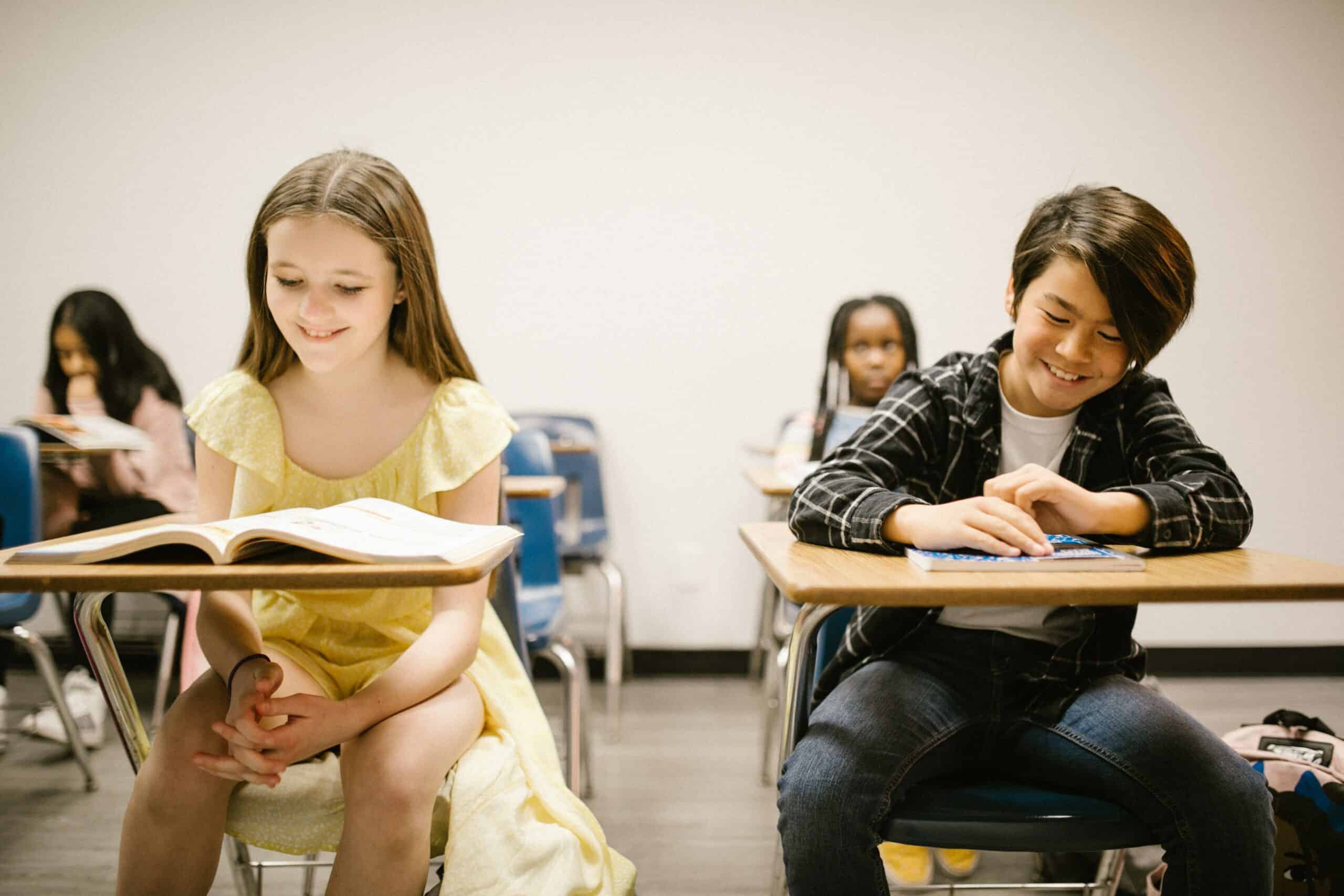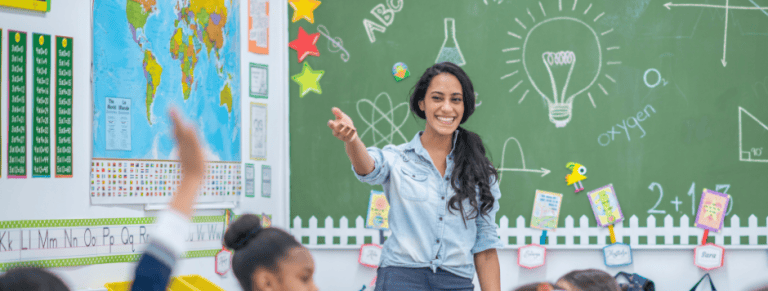Why Discussion Matters for Mattering: How to Teach Students the Power of Speaking & Listening
For many teachers, class discussion is a chance to dive into content: to unearth new meaning in a text, debate the impact of a historical event, draw connections among ideas.
At R.E.A.L.® we believe all of those things are true – but in today’s world, class discussion serves an even more important purpose: it may be the only time when students consistently engage in the deeply human experience of sustained, screen-free conversation.
Teachers, then, have an extraordinary opportunity (and, perhaps, responsibility): to help students feel seen, heard, and aware of the dynamics of human conversation. We know that adolescence today is defined at once by a sense of hypervisibility (“I have thousands of followers!”) and constant curation (“No one actually sees me as me”), and we see class discussion as an important method to teach the live communication skills kids find hard. These are skills for the defining experiences of their lives – things like falling in love, engaging in democracy and community, negotiating friendships over time, leading teams in the workplace.
Class discussion is also a way for students to experience and practice interdependence – that is, the skill of seeing, appreciating, and depending on each other in a world that’s obsessed with individual success and personal preferences. In a generation where one in four students says their career aspiration is to be an influencer, class discussion teaches students that yes, their individual voices matter – but so does listening and showing others they matter. Class discussion helps kids learn to give and take – and ultimately discover the power of exploring ideas together and in real-time.
Class discussion helps kids learn to give and take — and ultimately discover the power of exploring ideas together and in real-time.
The skill of interdependence is counter-cultural in today’s society, but it’s critical for our shared future – especially in an increasingly tech-centric world.
Showing Others They Matter: A Mindset That Must Be Taught in Today’s World
In a recent Atlantic article, David Brooks diagnoses an “emotional, relational, and spiritual crisis” gripping our country. He argues that the cause is not just social media or pandemic externalities, but the many ways in which society has come to emphasize self over others throughout the last half century. He writes, “Our society has become one in which people feel licensed to give their selfishness free rein, […] where emotivism [‘what I feel is right’] has become popularized” and algorithms further reinforce this pervasive narcissism. As I have written about elsewhere, today’s kids are growing up in a world that emphasizes individual success and is highly personalized – algorithms anticipate and reinforce desires, AI provides on-demand answers, even vocabulary and math platforms feed students personalized problems. In isolation, none of these things is bad, but taken together, it’s not surprising that today’s kids operate independently and struggle to connect with each other.
Essentially, Brooks argues that we have built a society that emphasizes the individual at the expense of the community, where interdependence is seen as a sign of individual weakness rather than path to collective strength. He describes a world characterized by people who have forgotten how to show each other a simple, central truth: that we matter.
I am an educator who has spent the last decade on a mission to teach, measure, and celebrate discussion skills, because I believe that, through discussion, students develop the skill of showing others that they matter and feel that they, too, matter to others. In my experience as an educator and citizen, I have found that moments of greatest strength and success come when people understand this – and when they work together rather than go it alone.
In my experience as an educator and citizen, I have found that moments of greatest strength and success come when people understand [that they and others matter] – and when they work together rather than go it alone.
I have also come to believe that interdependence is only possible if we can(re)learn how to talk – and truly listen – to each other. I have worked with over fifty schools to design discussion skills strategies, and I have learned that using class discussion to double-down on human skills and model interdependence is countercultural. But it’s necessary, powerful, and absolutely doable.
Now, it’s time to do it. The questions are why and how.
Why? Interdependence Helps Kids Learn That They Matter
At an individual level, interdependence fosters adolescent wellbeing: a case Jennifer Breheny Wallace lays out compellingly in her buzzy new book Never Enough: When Achievement Culture Becomes Toxic and What We Can Do About It. This makes intuitive sense: interdependence – the experience of mattering to each other – is a prerequisite for healthy relationships (as Nina Kumar, CEO of Authentic Connections, is fond of saying: for kids in high-achieving schools, “resilience rests on relationships”). On the other hand, an emphasis on individual achievement can undermine relationships and create pressure to achieve alone: not the recipe for happy kids (or good class discussion).
Wallace connects the idea of interdependence to the psychological concept of mattering. She footnotes psychologists Morris Rosenberg and Adam Flett in studying the correlation behind mattering and high self-esteem in adolescents and articulates seven ingredients to feeling like you matter: Attention (feeling that you are noticed by others), Importance (feeling like you are significant), Dependence (feeling like you are important because others rely on you), Ego Extension (recognizing that others are emotionally invested in you and care what happen to you), Noted absence (feeling like you are missed if you aren’t there), appreciation (feeling like you and your actions were valued), Individuation (being made to feel unique, special, and known for your true self) (Wallace: 53-54).
Class Discussion as a Tool for Showing Kids They Each Matter
Class discussion is ripe for teaching, measuring, and celebrating all seven components of mattering. A few examples: When you speak and see classmates nodding in response, you learn that you are being listened to. When a classmate speaks and references your point, you feel heard. If there’s a culture of equitable participation and you don’t speak, your classmates will pull you in and show they notice you. Your voice might get louder and you might feel an adrenaline rush as you get more excited and invested in the topic – and you learn that to every discussion, you bring your lived experience as well as interpretation of class texts. Your perspective is uniquely yours, and your classmates depend on and appreciate you for it. The list goes on!
At R.E.A.L.®, we measure the success of a discussion not just in terms of who-spoke-how-many-times or how-deep-did-you-get-into-content, but in terms of how it felt for students. Did they feel valued? Did they see value in their classmates? To do this, we survey students on the veracity of statements like: “When I speak, I feel like my classmates listen to me.” “I believe I bring a unique perspective worth sharing to the conversation.” “I can get my voice in if I have something to say.” “My thinking was changed or challenged today.”
Questions like these cue students to connect class discussion to a broader purpose – and the data empowers teachers to quickly assess if students are experiencing mattering and interdependence during discussion. With near-real-time feedback, teachers can design interventions to emphasize what their specific classes need: perhaps a mini-lesson about the difference between discussion and debate, a temporary rule where everyone only gets to talk twice, or a written reflection on the power of a classmate’s comment.
Class Discussion as a Tool For Teaching Kids to Show Each Other They Matter
Class discussion is a lever schools can pull to help children experience mattering and interdependence in the classroom – and teachers may need new training and tools to approach discussion in this way. But, it’s worth it: as Wallace says: the more we feel valued, the more likely we are to add value, and the other way around – a virtuous cycle of interdependence that can continuously feed our sense of mattering” (51). We want to make sure that class discussion is a time when all children feel valued, so they can add value – and do it together in an otherwise highly individualistic world.
We want to make sure that class discussion is a time when all children feel valued, so they can add value – and do it together in an otherwise highly individualistic world.
At R.E.A.L.®, we’re here to help make pulling that lever a little easier. We give teachers the training and tools they need to help today’s students survive and thrive during in-person discussion.
And students see the impact. In our periodic surveys, they say things like:
- “Jennifer picked up on my comment and disagreed which then opened new avenues for the conversation and honestly I hadn’t really thought about many of the opinions raised before.”
- “I know people were listening because when I was talking I saw the NVC [non-verbal hand signal, meaning ‘I agree’] which gave me confidence to keep going.”
- “I couldn’t believe when I got a shout out from Matt for my comment. He said he was going to build on that idea in his paper! I didn’t really think people listened but then I saw they did and what I say can be useful.”
Want to have a conversation about discussion and mattering? You know we’d love to. Get in touch: hello@realdiscussion.org.






